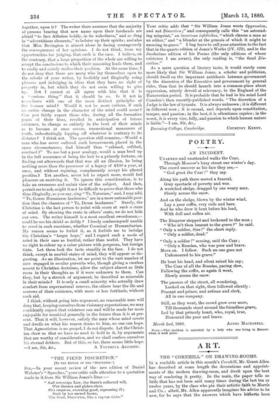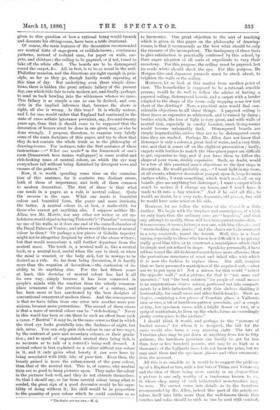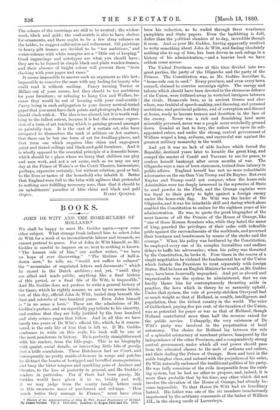ART.
•
THE " CORNHILL " ON DRAWING-ROOMS.
IN a readable article in this month's Cornhill, Mr. Grant Allen has described at some length the decorations and appoint- ments of the modern drawing-room, and dwelt upon the best way of rendering it pretty. In the main, the paper tells us little that has not been said many times during the last ten or twelve years, by the class who pin their artistic faith to Morris and Co.; albeit, Mr. Allen apparently imagines his advice to be new, for he says that 'the answers which have hitherto been
given to this question of how a rational being would furnish and decorate his sitting-room, have been a trifle irrational.
Of course, the main features of the decoration recommended are neutral tints of sage-green or reddish-brown ; continuous patterns, instead of isolated ones, for paper on walls, car- pets, and chintzes ; the ceiling to be papered, or if not, toned to take off the white effect. The boards are to be distempered round the carpet, &c. All, in fact, is to be as usual in the anti- Philistine mansion, and the directions are right enough in prin- ciple, as far as they go, though hardly worth repeating at this time of day. But underlying even these simple direc- tions, there is hidden the great artistic fallacy of the present day, one which bids fair to ruin modern art, and finally, perhaps, to send us back howling into the wilderness whence we came. This fallacy is as simple a one as can be desired, and con- sists in the implied inference that, because the above is right, all else is wrong. Is this true ? It is wholly untrue, and I, for one, would rather that England had continued in the state of crass artistic ignorance prevalent, say, five-and-twenty years ago, than that it should come to be supposed that the decoration of houses must be done in one given way, or else be done wrongly. I propose, therefore, to examine very briefly some of the main doctrines of this paper, and try to show that they do not contain the whole truth as to the philosophy of drawing-rooms. For instance, take the first sentence of these
instructions What one needs * in the framework of one's room [framework here means wall-paper] is some restful and rich-looking mass of neutral colour, on which the eye may everywhere fall without being disturbed by divergent rows and crosses of the pattern."
Now, it is worth spending some time on the examina- tion of this sentence, for it contains two distinct errors, both of them of importance, and both of them common to modern decoration. The first of these is that what one needs in a paper, as a rule, is neutral colour. Quite the reverse is the case. What one needs is beautiful colour and beautiful form, the purer and more intricate, the better. A neutral colour is, at best, a make-shift, for those who cannot get anything else. I suppose neither Mr. Allen, nor Mr. Morris, nor any other art writer or art up- holsterer,would object to having Tintoretto's "Paradise" covering up one of his walls, as it does one end of the council-chamber of the Ducal Palace at Venice ; and where would the mass of neutral colour be then ? Or perhaps a few pieces of Gobelin tapestry might not be altogether despised by either of the above writers ; but that would necessitate a still further departure from the neutral mass. The truth is, a neutral wall is, like a neutral book, or a neutral food, useful when the eye is tired, or when the mind is wearied, or the body sick, but in noways to be desired as a rule. So far from being decoration, it is hardly more than the negation of decoration,—the confession of in- ability to do anything else. For the last fifteen years at least, this doctrine of neutral colour has had it all its own way, simply because it has been connected in people's minds with the reaction from the utterly common- place ornament of the previous quarter of a century, and has been more or less sanctioned by the best designer of conventional ornament of modern times. And the consequence is that we have fallen from one error into another more per- nicious, because more pretentious. The second of these errors is that a mass of neutral colour can be " rich-looking." Never
in this world has been or can there be such an effect from such a cause. Restful " it may be, in the same sense as that in which the tired eye looks gratefully into the darkness of night, but rich, never. You can only gain rich colour in one of two ways, by the contrast of pure and secondary colours, or their grada- tion; and to speak of ungradated neutral tints being rich, is as accurate as to talk of a convict's being well dressed. A neutral colour is best explained as a colour without any colour in it, and it only gains what beauty it can ever have by being associated with little bits of pure tint. Even then, the beauty gained is more the enhancement of the pure colour, than that of the neutral tint. This is, of course, why neutral tints are so good to hang pictures upon. They make the colour in the pictures look well, and they do not obtrude themselves. So that I should say, so far from neutral colour being what is needed, the great sign of a good decorator would be his capa- bility of doing without it ; his skill would be ill proportion to the quantity of pure colour which he could combine so as
* The italics are my Q.
to harmonise. One great objection to the sort of teaching which is given in this paper on the philosophy of drawing- rooms, is that it recommends as the best what should be only the resource of the incompetent. The inadequacy of these tints to give satisfaction is practically confessed by this school, by their eager adoption of all sorts of expedients to vary their monotony. For this purpose, the ceiling must be papered, lest its crude white should shock the eye. For this purpose, De Morgan tiles and Japanese parasols must be stuck about, to brighten the walls or the ceiling.
However, let us look at this matter from another point of view. The householder is supposed to be a rational, sensible person ; would he do well to follow the advice of having a papered ceiling, distempered boards, and a carpet with a border adapted to the shape of the room, only stopping some few feet short of the skirting ? Now, a practical mau would find con- siderable objections to all these things. A papered ceiling is three times as expensive as whitewash, and is ruined by damp ; besides which, the loss of light is very great, and with walls of neutral tint, especially in smoky London, most living-rooms would become unbearably dark. Distempered boards are simply impracticable, unless they are to be distempered every time they are washed. Perhaps Mr. Allen does not know that distemper is only a colour, a great deal of water, and a very little size, and that it comes off on the slightest provocation ; lastly,
carpets with borders to match the blue-green paper are difficult to get, expensive to buy, and if you have them to follow the shape of your room, doubly expensive. Such, no doubt, would be a few of this practical man's objections to the first steps in decoration. He would probably say,—" I want light in my room, at all events, whatever decoration you put upon it, keep its main surface white ; I want something which won't wash off on my boards, give me anything but distemper ; I want a carpet which won't be useless if I change my house, and I won't have it made to fit into a bay window." And if he said all this, he would, no doubt, be a very rude, dogmatic, old person, but still he would have some sense on his side.
However, let me follow the writer of the G r;a&ill a little further. We begin with the fireplace and mantelpiece, of which we only learn that the ordinary ones arc " hopeless," and that any attempt to modify them will be a transparent make-sh ift,— it is necessary, it seems, to have a new one, with blue tiles, Si c., and " warm-looking stone jambs ;" and the chairs are to be arranged in a cosy semicircle, round the hearth. Well, this is a hard saying, especially to those who know how difficult it is to get any really good blue tiles, or to construct a mantelpiece which shall be simple and yet refined in shape. Speaking personally, I have seldom found the old-fashioned mantelpiece more offensive than the pretentious structures of wood and inlaid tiles with which it is now the fashion to replace them. But still, imagine that we have procured a mantelpiece of the required sort,—what are we to put upon it ? Not a mirror, for that would " reflect the opposite wall ;" not a picture, for that is " too same and unvaried :" but " the best solution" for people of small means is an unpretentious etagere mirror, portioned out into compart- ments by a little balustrade, and with thin shelves dividing it horizontally, for small vases and other knickknacks. Such an 6tagre, containing a few pieces of Venetian glass, a Vallauris vase or two, a hit of hawthorn-pattern porcelain, and a couple of tiny, low specimen vases, with a bright flower or two, or a sprig of maidenhair, to liven up the whole, forms an exceedingly pretty centre-piece to the picture."
I should think it would, and perhaps to the " persons of limited means," for whom it is designed, the bill for the same would also form a very amusing sight. The bits of Venetian glass may be put down at anything from five to fifty guineas ; the hawthorn porcelain can hardly be got for less than four or five hundred pounds, and may be as high as a thousand ; of the Vallauris vases I do not know the price, but we may omit them and the specimen glasses and other ornaments from the account.
All this is as sensible as it would he to suggest the picking- up of a Raphael or two, with a few bits of Titian and Veronese ; and the idea of there being more variety in an étag;;re than a picture is one only worthy of a tradesman known to us, in whose shop many of such balustraded monstrosities may be seen. We cannot enter into details as to the furniture recommended by Mr. Allen, indeed this part of the article re- solves itself into little more than the well-known thesis that couches and sofas should be such as can be used with comfort.
The colours of the coverings are still to be neutral ; the wicker- work, black and gold ; the coal-scuttle is also to have shelves for ornaments, and there ought to be a few stray volumes on the tables, to suggest cultivation and refinement. Oil paintings in heavy gilt frames are decided to be " too ambitious," and water-colours with white margins are a " little out of keeping." Good engravings and autotypes arc what you should have; they are to be framed in simple black and plain wooden frames, and their absence of bright colour will prevent them " from clashing with your paper and vases."
It seems impossible to answer such an argument as this last; impossible to conceive the man with any feeling for beauty who could read it without smiling. Fancy turning Turner or Millais out of your rooms, lest they should be too ambitious for your furniture ; or refusing to hang Cox and Walker, be- cause they would be out of keeping with your coal-scuttle ! Fancy being in such subjugation to your dreary neutral-tinted paper that you must have dark prints and photographs, lest they should clash with it. The idea is too absurd, but it is worth real- ising to the fullest extent, because it is but the extreme expres- sion of a form of art teaching which is gaining ground amongst us painfully fast. It is the cant of a certain set, who have arrogated to themselves the rank of arbiters on Art matters, that there can be but one form of art for dwelling-places, and that form one which requires blue china and sage-green paint and tinted ceilings and black-and-gold furniture. And it is wholly opposed to the essential principle of a domestic house, which should be T. place where we fancy that children can play and men work, and not a set scene, such as we may see any day at the Prince of Wales's or the Court Theatre, harmonious, perhaps, expensive certainly, but without relation, good or bad, to the lives or tastes of the household who inhabit it. Better that England were full to the brim with ugliness that pretended to nothing save fulfilling necessary uses, than that it should be an upholsterers' paradise of blue china and black and gold




































 Previous page
Previous page